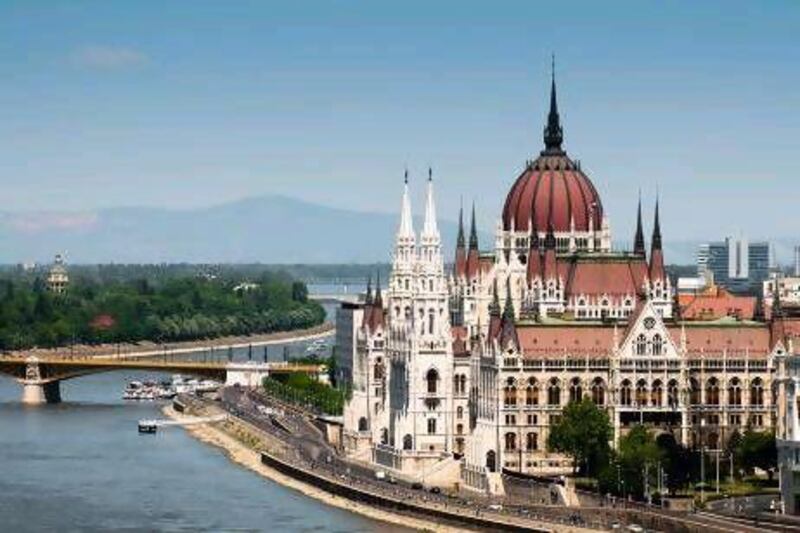Budapest was the first city in continental Europe to build a metro system. Line One, the original 19th-century route, is an atmospheric tour through the city's past. Jamie Lafferty hops aboard.
London won the race to the underworld. Perhaps that's not a surprise given the wealth of the British Empire at the end of the 19th century. But the next city to successfully build an underground network wasn't Paris, nor New York, nor Glasgow, the British Empire's second city. It was Budapest, in May 1896, that became the first city in continental Europe to open a metro system.
The intervening years have seen Budapest's fortunes rise and fall with political and economic fluctuations, but the original route - the iconic Line One - has remained unaltered. Now celebrating 10 years on Unesco's world heritage list, Line One has become especially popular with tourists. Three other lines have been added around the city, yet this original route has many stops next to some of the most important cultural attractions in the city. The route has inadvertently become a kind of tour through Hungary's glorious past.
For such an old system - the trains are 40 years old - the doors shut surprisingly brusquely, opening for just a few seconds. Dashing commuters are unanimously disappointed if they fail to make it before the doors snap shut; so brief are these stops that it only takes the train 20 minutes to complete the entire run. Thankfully, the trains in Budapest are incredibly frequent - at peak times another one will rattle into the station just two minutes later.
Line One starts (or ends) in the middle of Café Gerbeaud, one of the finest coffee shops in Europe. Built in 1870 at the height of the Grunderzeit boom period, its bold white stucco facade dominates the square on which it's built. During the hot summer months, its al fresco tables surround the exit to Vorosmarty Ter, the metro's first station. The cafe predates the rail system by 26 years but, like the trains, their strong coffee and delicate pastries have almost never been out of fashion. In a city filled with historic architecture, this is one of the few buildings to have been continuously inhabited by the same business; though many of the surrounding units were built during the same era, they're now filled with predictable international chains. Yet the people who seek out expensive brands in those shops still fill the tables at Café Gerbeaud, their overflowing bags waiting patiently at their side while they top up on caffeine.
It's a surprise to many who come to the city, but Budapest was once two separate villages. The settlement on the western banks of the Danube was called Buda, while Pest lay in the east. Line One is contained entirely on the Pest side, and from Gerbeaud, it heads farther away from the busy riverside.
Deak Ferenc Ter is the next stop. Budapest's town hall is near here, as are a series of bakers in little wooden huts, teasing politicians with the smell of their fresh bread. Perhaps more interesting for visitors is the Foldalatti Vasut museum, which is dedicated to the development of the rail network. Some of the original carriages are stored down here, as well as dozens of photographs detailing the complicated construction and opening of Line One. It's a trainspotter's dream.
The next stop is a stone's throw away from the obscenely opulent St Stephen's Basilica, which lends its name to the station. Hungary was heavily punished for picking the defeated sides in both world wars, losing more than 70 per cent of its territory, but 100 years ago it was booming as one of Europe's great superpowers. The basilica is one of the most conspicuous statements of those grandiose, plentiful times, with gigantic spires and an awe-inspiring dome that, at 96 metres, makes it the one of the two tallest buildings in Budapest. Almost 9,000 worshippers can fit in here, though anyone is welcome to look around when services aren't taking place. Those with strong enough legs can also plod up the 364 stairs for commanding views across the city, while virtually anyone can have a look at the eerie, mummified hand of St Stephen, the first king of Hungary. Separated from its owner for a millennium, it's stored in a protective case.
There were many reasons for Budapest to construct its subterranean network, but chief among them was to mark the 1,000-year anniversary of the arrival of the Magyars. Led by Stephen's great-grandfather Arpad, they settled in the region in AD 896 and, perhaps motivated by their legacy, the rail engineers finished the project in less than two years, well ahead of schedule.
But another key reason for their ambitious project was to reduce traffic on the picturesque Andrassy Avenue. The automobile was slowly gaining popularity and town planners feared for the aesthetic of their grand city - by building underground, they would keep the surface clutter-free.
Ironically, Andrassy Avenue remains one of the most traffic-choked streets in all of Budapest, even though the pioneering Line One still rumbles away underneath. After the basilica, the majority of the stops are along this famous street. The Opera station is home to another chunky masterpiece of design, the State Opera House, which opened in 1886 in the midst of Budapest's glory days. Contemporary Magyars enjoyed the same shows as their forebears: Macbeth, Madame Butterfly and Tosca. The theatres built around the next stop, Oktogon, are similarly impressive - not surprisingly, they were built in the same era.
But at the sixth stop, there's suddenly something more modern. The House of Terror, just outside the Vorosmarty Utca station, may sound like a cheap attraction at a fairground, but it is one of the most imaginative, haunting museums on the continent. Having been occupied by the Nazis during the Second World War, Hungary found itself immediately occupied by the Soviet Union, which ruled until 1989. This double invasion devastated the country, with the sinister State Protection Authority, a kind of secret police, torturing and executing thousands of their countrymen in a bid to control the nation.
The House of Terror handles Hungary's past with admirable objectivity, and it's not shy about bold design, either. Many of its exhibitions feel like art installations, with creativity and huge amounts of imagination delivering an unforgettable experience.
It's all so intense that it almost comes as a relief to be back outside and on the train again, especially when stepping out of Hosok Tere station and into the airy Heroes Square at the end of Andrassy Avenue. Flanked by a series of imposing buildings such as the Museum of Fine Arts and Kunsthalle, a contemporary art museum, the square is full of bronze monuments to great figures from the past including Stephen, hand still attached and clutching an imposing sword.
Szechenyi Furdo, the penultimate station, is just a few hundred metres away and the last stop really worth visiting. For children, the city's zoo is near here, as is the sprawling Szechenyi medicinal bath, which channels hot water from two thermal springs and is the biggest bath of its kind in Europe. In their own ways, they're both hectic, noisy places.
Outside, the atmosphere in City Park is more soporific. Ice cream sellers fringe the greenery and couples canoodle beneath trees. At ancient tables, old men play chess, sucking hard on smoking pipes when their schemes go ill. Like the majority of stops on Line One, it's a scene that hasn't changed since the Hungarians opened their passage to the world below.
If You Go
The flight Qatar Airways flies daily from Abu Dhabi to Budapest, via Doha, with flights starting from Dh2,500 (www.qatarairways.com)
The hotel The four-star Hotel Palazzo Zichy was once a small palace for a noble family on the Pest side of the city. It fell into ruin for a number of years, but was spectacularly revived and opened to visitors in recent years. Rooms start from just €79 (Dh367) per night, including taxes (www.hotel-palazzo-zichy.hu; 00 36 1 235 4000)
The info The Budapest Metro remains one of the most affordable, efficient ways to travel around the city, with day tickets starting from Dh25. Line One is the most historic route, but it's not the only one in town – there are now four in total, covering the majority of the city's regions (www.bkv.hu)





